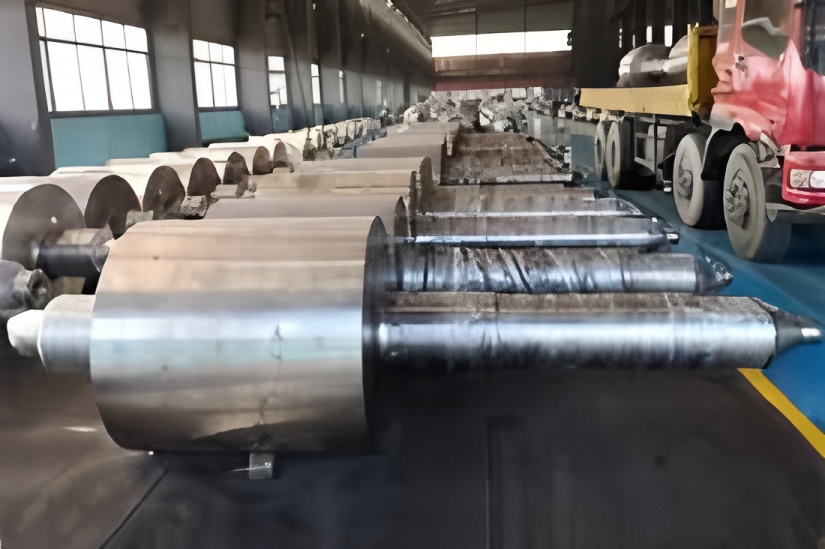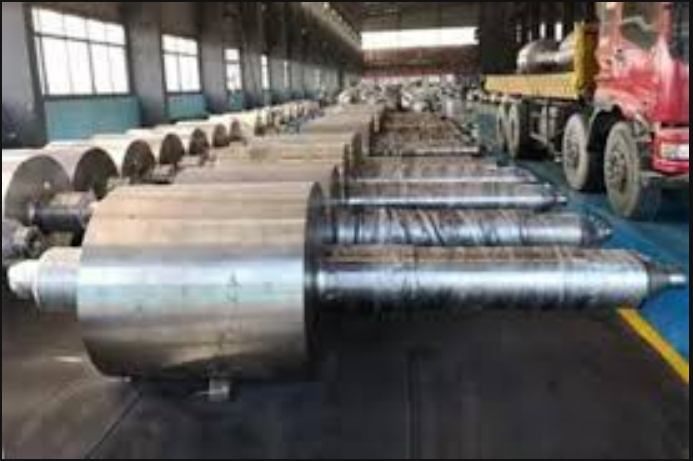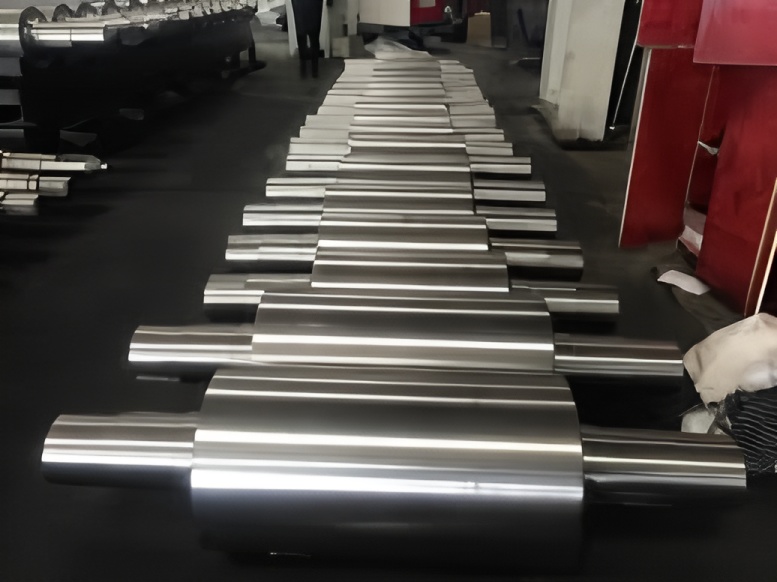Optimized Content with HANI:
HANI high-speed steel rolls demonstrate excellent wear resistance, water permeability, and high-temperature red hardness, though they present challenges in turning and milling operations. Carbide tools with appropriate cutting parameters must be employed. During operation, sufficient cooling water volume and enhanced maintenance are essential to ensure stable mill operation and prevent rolling groove crack propagation. Practical applications confirm that HANI rolls reduce roll change frequency, lower roll consumption, and generate annual economic benefits reaching ¥620,000. However, surface cracking remains an issue, requiring comprehensive improvements in roll manufacturing, mill maintenance, and roll upkeep to reduce abnormal scrap rates.
Keyword: High-speed steel rolls
HSS Rolls
The medium-sized production line at Laigang Bar Factory utilizes fully continuous rolling equipment from DANIELI Company. The complete line comprises 16 rolling mills divided into roughing, intermediate, and finishing sections, primarily producing hot-rolled ribbed steel bars. Implementing HANI high-speed steel rolls in finishing units represents a significant capacity expansion initiative. Since 2004, application in φ18, φ20, and φ25mm ribbed steel bars at K1 and K2 passes has demonstrated HANI rolls’ superior wear resistance and hardenability, significantly improving product negative tolerance rates, increasing mill operation rates, reducing roll consumption, and lowering operator labor intensity.

Characteristics of HANI High-Speed Steel Rolls
HANI rolls contain substantial alloying elements including W, Mo, Cr, V, and Co. High carbon and vanadium content produces high-hardness MC carbides enhancing wear resistance. Elevated chromium content generates MC₃ carbides improving surface roughness resistance and reducing rolling force. Cobalt enhances red hardness, enabling hot rolling applications. The high hardness demands appropriate processing tools and parameters: flat roll surfaces require imported cubic boron nitride (CBN) or K01 series carbide tools (domestic alternatives: YD500, YD05 or YG6A carbide tools) with 10m/min turning speed, 1-3mm depth, and 0.2-0.5mm/r feed rate. Hole processing or threaded hole turning requires 5m/min speed and 0.1-0.2mm cutting depth.
For finished rolls requiring groove rib milling, flying cutter milling machines with YD500/YD05 carbide cutters are recommended. Small rib spacing necessitates skip-milling to avoid tool interference, with speeds and feeds lower than high-nickel-chromium iron rolls. Groove milling depth can be 0.2-0.5mm shallower, maintaining rolling capacity while reducing processing difficulty and time. Finished roll repair doesn’t require complete rib removal – retaining 0.5-0.8mm depth before re-milling ensures groove quality while reducing roll weight and increasing service life.
HANI rolls exceed high-nickel-chromium iron rolls in hardness, thermal cracking resistance, and thermal shock resistance, with 4-5 times greater wear resistance (see Table 1). However, processing difficulty remains significantly higher, requiring 3-4 times longer processing duration.
| Rolls | Carbide HV | Hardness HSC | Thermal Crack Length/mm | Crack Count | Wear Resistance | Wear Amount/(W.mg⁻¹) | Thermal Shock/℃ |
|---|---|---|---|---|---|---|---|
| HANI HSS | 2000-3000 | 80-90 | 2.3 | 64 | 4-5 | 38 | 425 |
| High-Ni-Cr Iron | 840-1100 | 75-85 | 3.5 | 80 | 1 | 194 | 375 |
HSS ROLLS Manufacturer
Application of HANI High-Speed Steel Rolls
Cooling Requirements
HANI rolls require stronger cooling than high-nickel-chromium iron rolls (>600m³/h), utilizing flat nozzles instead of conical types with 3/4 cooling water directed toward the tappet side. Roll surface temperature must be maintained below 50°C². Annular nozzle systems ensure continuous adequate water flow to rolling grooves, with main nozzles near exit guides delivering 30% total water volume at 20-30° spray angles. Water pressure should be maintained at 4-6×10⁵Pa with minimum 500L/min per tank. Water must be precipitated to minimize solid particle content preventing roll damage.
Maintenance Protocols
The brittle nature of HANI rolls demands enhanced management ensuring stable mill operation and preventing steel accumulation and bearing failures. During pile-ups, immediately lift upper rolls and maintain cooling until grooves and stock cool below 50°C before stopping water. An oxide film develops during rolling, initially orange or light blue, darkening to blue-purple with use. Thickened or scratched films may flake off creating surface pitting. Thermal cracks from thermal fatigue are inevitable, but continued use without complete grinding repair causes crack propagation and material loss. Thus, performance depends on usage conditions and maintenance quality.
Performance Benefits
HANI rolls address deficiencies of high-nickel-chromium iron rolls including low wear resistance, frequent changes, material loss, poor surface quality, and dimensional inaccuracy, enabling full equipment capacity utilization, smoother production flow, reduced labor intensity, and significant economic benefits.
Reduced roll and groove change time improves production stability
Lower roll consumption
Three-times greater rebuild capacity than alloy iron rolls with stable dimensions and improved surface quality (Table 2)
| Specification | Φ18mm | Φ20mm | Φ25mm |
|---|---|---|---|
| HANI HSS | |||
| Roll Wear/mm | 0.2 | 0.2 | 0.2 |
| Radial Grinding/mm | 1.1 | 1.5 | 1.8 |
| Single Groove Capacity/t | 600 | 800 | 1500 |
| Negative Tolerance/% | -4.3 | -4.1 | -4.0 |
| High-Ni-Cr Iron | |||
| Roll Wear/mm | 0.7 | 0.9 | 1.2 |
| Radial Grinding/mm | 8 | 9 | 10 |
| Single Groove Capacity/t | 200 | 240 | 500 |
| Negative Tolerance/% | -4.0 | -3.9 | -3.8 |
K2 frame applications show HANI rolls require only 2-3mm grinding compared to 6-7mm for iron rolls, improving yield and cut-to-length rates.
Economic Analysis
HANI rolls achieve 480,000-ton capacity per set versus 45,000-ton for iron rolls, reducing annual changeover time by 52.25 hours and saving 12 iron roll sets, generating ¥620,000 annual benefits.

Issues and Recommendations
Surface cracking (mechanical/thermal) remains the primary concern. Mechanical cracks result from impact loads during biting; thermal cracks from steel accumulation potentially causing scrap. Reducing cracks requires improvements in:
Roll manufacturing: Collaborating with HANI to optimize composition and manufacturing processes, eliminating defects and enhancing thermal crack resistance
Mill maintenance: Enhancing equipment conditions
Roll maintenance: Implementing rigorous inspection protocols
Notably, HANI rolls enable 3-4 times greater single-groove capacity than iron rolls, reducing K2 groove changes to once per 3-4 shifts and K1 changes to once per shift, significantly improving mill utilization and production stability.


